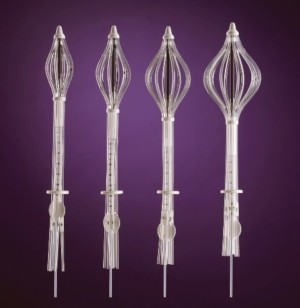
Insertion of the radiation delivery device for a five-day high dose rate (HDR) brachytherapy treatment after lumpectomy. Designed to reduce the burden of breast cancer on women and their families.
Accelerated Partial Breast Irradiation (APBI) with brachytherapy offers significant advantages: lower toxicities and better cosmesis due to a reduction in total radiation exposure and a reduced treatment duration. Since its introduction in the late 1990s, more than 150,000 women in the U.S. have received ABPI brachytherapy.
Historically women have been treated with whole breast radiation using an external beam to deliver radiation to the entire breast over a period of 3 to 7 weeks of daily treatments.
Women have reported unpleasant side effects due to excessive radiation exposure to healthy tissue, as well as the skin, ribs, heart and lungs. In addition, the long treatment schedule can significantly disrupt a woman’s life, whether it’s interference with family, the cost of missed work, or the difficulty of traveling to a medical facility every day for 3 to 7 weeks.
SAVI Brachy is a form of accelerated partial breast irradiation (also known as APBI and is a more contemporary standard of care. Extensive research over the past decade indicates APBI can be as effective as whole breast radiation in preventing local recurrences.
SAVI Brachy offers significant advantages over whole breast irradiation, mainly because the radiation dose can be customized and delivered to precisely where it is needed. Healthy tissue is spared from unnecessary radiation and treatment time is reduced from several weeks to just five days or less.
SAVI Brachy uses thin tubes (catheters) to deliver radiation directly to the lumpectomy site. The catheters gently expand to fit the size and shape of the tumor cavity. A tiny radiation seed travels through each catheter to deliver a precise dose of radiation, customized for the exact size, shape or location of your tumor cavity.

Placement
The SAVI Brachy applicator is gently inserted in a closed position into the tumor cavity through a small incision, a procedure that is usually done in Dr Santillan’s office.

Expansion
The catheters are gently expanded to conform to the shape of your cavity. This is done only once, at the beginning of your treatment.

Radiation Delivery
Once the catheter is in place, you will go to your radiation oncologist at Texas Oncology to begin treatment, which is delivered twice a day for five days or less. The ends of the catheters are connected to a computerized delivery system that painlessly delivers a tiny radioactive seed into each tube. The radiation source is completely removed after each treatment - no radiation remains in your body between treatments.

Removal
After your last radiation treatment, Dr. Santillan will close the device and remove it through the same incision into which it was originally inserted.
